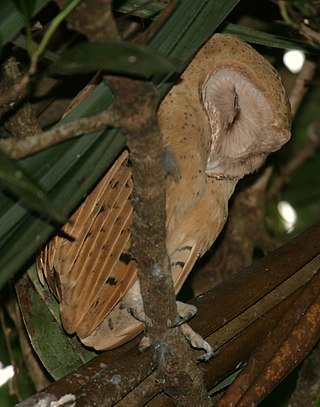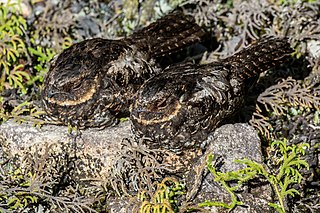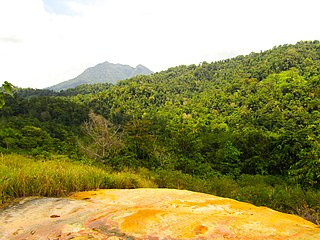
Barn-owls are one of the two families of owls, the other being the true owls or typical owls, Strigidae. They are medium to large owls with large heads and characteristic heart-shaped faces. They have long, strong legs with powerful talons. They also differ from the Strigidae in structural details relating in particular to the sternum and feet.

The red owl is an owl in the barn owl family Tytonidae. It is also known as the Madagascar red owl, Madagascar grass-owl and Soumagne's owl. It is a rare resident of Madagascar that was virtually unknown from its discovery in 1876 to its rediscovery by researchers from the World Wide Fund for Nature in 1993. It is currently listed as vulnerable because of habitat loss, but recent studies have determined it may have a wider range than first believed, though further research in distribution and ecology is required. It has possibly been overlooked because of its close resemblance to the closely related barn owl.
The Taliabu masked owl, also known as the Taliabu owl or the Sula Islands barn owl, is an owl in the barn owl family, Tytonidae. This is one of the two groups of owls, the other being the typical owls, family Strigidae. It is endemic to Taliabu Island of Indonesia.

Tyto is a genus of birds consisting of true barn owls, grass owls and masked owls that collectively make up all the species within the subfamily Tytoninae of the barn owl family, Tytonidae.

The greater sooty owl is a medium to large owl found in south-eastern Australia, Montane rainforests of New Guinea and have been seen on Flinders Island in the Bass Strait. The lesser sooty owl, is sometimes considered to be conspecific with this species, in which case they are then together referred to as sooty owls. It is substantially smaller and occurs in the wet tropics region of North Queensland, Australia.

The Australian masked owl is a barn owl of Southern New Guinea and the non-desert areas of Australia.

The Satanic nightjar, also Heinrich's nightjar, satanic eared-nightjar, Sulawesi eared-nightjar or diabolical nightjar is a mid-sized, spotted, dark brown nightjar endemic to the Indonesian island of Sulawesi. The species was discovered in 1931 by Gerd Heinrich, a German natural historian who collected a single female holotype from Mount Klabat on the Minahasa peninsula of Northern Sulawesi.

The Siau scops owl is a critically endangered owl species. They live on Siau Island, north of Sulawesi, Indonesia and are (were) forest dwellers. The species is only known from a single holotype from 1866 although there have been more recent potential sightings, including one in 2017. Even so, their habitat is being lost to excessive logging of the forest on the island and there would be very few if any individuals left. The taxonomic arrangement for this owl has not been fully worked out. While recognized as a distinct species by the IOC, others consider it as a subspecies of either the Sulawesi scops owl or Moluccan scops owl.

The lesser sooty owl is a medium-sized barn owl endemic to the wet tropics region of Australia. Once considered a subspecies of the greater sooty owl, it is distinguished by its dark plumage, heavier spotting, and higher-pitched call. The lesser sooty owl has a limited range within northeastern Australia and primarily lives in dark, sheltered areas of the rainforest.

The western hooded pitta is a passerine bird in the family Pittidae. It is common in eastern and southeastern Asia and maritime Southeast Asia, where it lives in several types of forests as well as on plantations and other cultivated areas. It is a green bird with a black head and chestnut crown. It forages on the ground for insects and their larvae, and also eats berries. It breeds between February and August, the pair being strongly territorial and building their nest on the ground. Incubation and care of the fledglings is done by both parents. The bird has a wide range, and the International Union for Conservation of Nature has assessed its conservation status as being of "least concern". It was formerly considered to be conspecific with the Nicobar hooded pitta, the Minahasa hooded pitta, the eastern hooded pitta and the Biak hooded pitta.

The golden masked owl is a barn owl endemic to the island of New Britain, Papua New Guinea. It is also known as New Britain barn owl, New Britain masked owl, Bismarck owl and Bismarck masked owl.

Bogani Nani Wartabone National Park is a 2,871 km2 (1,108 mi2) national park on Minahassa Peninsula on Sulawesi island, Indonesia. Formerly known as Dumoga Bone National Park, it was established in 1991 and was renamed in honour of Nani Wartabone, a local resistance fighter who drove the Japanese from Gorontalo during World War II. The park has been identified by Wildlife Conservation Society as the single most important site for the conservation of Sulawesi wildlife and is home to many species endemic to Sulawesi.

The cinnabar boobook, also known as the cinnabar hawk-owl, is a hawk-owl endemic to the island of Sulawesi, Indonesia. It was described as a new species to science by American ornithologist Pamela C. Rasmussen in 1999 based on a single specimen collected by Frank Rozendaal from Bogani Nani Wartabone National Park on Minahassa Peninsula, northern Sulawesi, in 1985. Subsequently, it has also been observed in Lore Lindu National Park in central Sulawesi, greatly expanding the known habitat range.
The Itombwe owl is a species of owl in the barn owl family, Tytonidae. It is restricted to a small area in the Albertine Rift montane forests.

The ashy-faced owl is a species of bird in the barn-owl family Tytonidae. It is found on the Caribbean island of Hispaniola, on Dominica, and on several other islands of the Lesser Antilles.

The eastern grass owl, also known as Chinese grass owl or Australasian grass owl, is a species of owl in the family Tytonidae. They feed predominantly on small rodents.

The Sulawesi masked owl is a species of owl in the family Tytonidae. It is endemic to the Indonesian islands of Sulawesi, Sangihe and Peleng. It is listed by the IUCN as being of least concern.

The scaly-breasted kingfisher or regent kingfisher is a species of bird in the family Alcedinidae endemic to central and southwestern Sulawesi in Indonesia. Its natural habitat is subtropical or tropical, moist, montane forests.
The Seram masked owl is an owl species in the family Tytonidae endemic to Seram Island in Indonesia. After being first brought to the attention of the world from a photograph taken during an expedition by Rudi Badil and Sukianto Lusli in the Manusela National Park in Seram in 1987 the holotype was mist-netted on 10 February 2012 and this species was formally described in 2013. The species' epithet commemorates Alma Jønsson, the daughter of Knud Andreas Jønsson, one of the describers of the Seram masked owl.

The northern masked owl is a large forest owl in the family Tytonidae. The northern kimberli subspecies was identified as a novel race of the Australian masked owl by the Australian ornithologist Gregory Macalister Mathews in his 1912 reference list of Australian birds. The northern masked owl occurs in forest and woodland habitats in northern Australia, ranging from the northern Kimberley region to the northern mainland area of the Northern Territory and the western Gulf of Carpentaria. While the Australian masked owl is recognized as the largest species in the family Tytonidae, the northern masked owl is one of the smallest of the Australian masked owl subspecies.


















